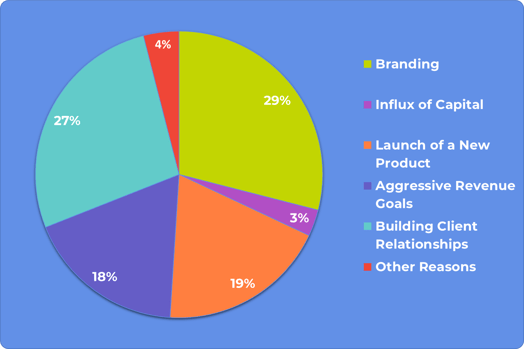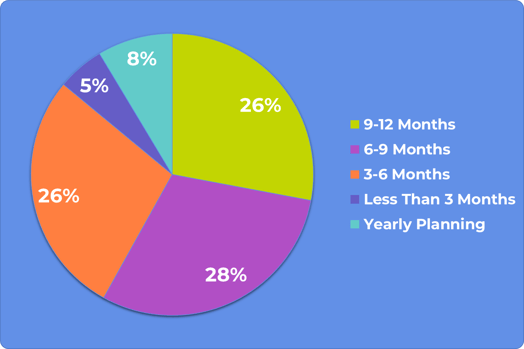How do you maximize your brand impact in a large exhibit space?
There are many factors to consider when preparing to exhibit in a large footprint. Bringing your brand to life requires strategic planning to ensure you achieve your business objectives and make the most of your investment.
What drives companies to scale up to a large exhibit space? In a recent survey we conducted, 29% of exhibitors reported branding as their driver, 27% said building client relationships, 19% reported the launch of a new product, 18% reported aggressive revenue goals, 3% reported an influx of capital, and the remaining 4% reported other reasons.

Five key reasons why companies will invest in a large exhibit:
1) Branding
Exhibits are a powerful tool and can be used to increase or strengthen your current brand positioning, reposition, or refresh your brand, or consolidate multiple brands under one parent brand. Tying your brand evolution to events accelerates awareness by connecting you directly with many clients, prospects, and the media.
2) Influx of Capital
This is often the case when start-up companies receive investment from a venture capitalist or parent company. Investing this capital in a large exhibit space provides an exciting opportunity to punch above your weight class and increase brand presence. It’s essential to design your exhibit to make an impact and project energy and personality. This is your chance to make a splash, tell your brand story, and gain as much attention as possible.
3) Launch of a New Product
Trade shows are an excellent platform for launching a new product and creating awareness. Face-to-face conversations allow you to receive feedback and answer questions. Including product demos and videos in your exhibit design gives your audience an easy and interactive way to learn about a new product. In addition to your audience, industry influencers, analysts, and reporters are often present at trade shows.
4) Aggressive Revenue Goals
A large exhibit is an excellent tool to achieve revenue goals by generating leads and progressing sales through the pipeline. It’s important to identify your KPIs (key performance indicators), develop an educational attendee journey, and outline a clear way to qualify your leads. Define booth activities, such as product demos, digital activations, or scheduling one-on-one meetings. Double-decker exhibits are a great way to incorporate a private meeting space or area to host a reception.
5) Building Client Relationships
Trade shows are the perfect setting to speak with your clients in person, which builds and strengthens your relationships. Creating a welcoming environment is important when designing your large exhibit – somewhere your clients will stay and hang out. This could be reception and seating areas where they can relax, have a snack or beverage, and charge their phone, or private meeting spaces for in-depth conversations. They may not know what’s new with your brand, so take the opportunity to update them. Make your clients feel special by reaching out ahead of the show to schedule meetings or providing a gift when they visit your booth. Increasing dwell time within your exhibit ensures you won’t lose your clients to competitors’ booths.
High-Impact Exhibit Design
A large exhibit is a significant investment in time, cost, and resources. However, there are many benefits to justify a more considerable spend. A large exhibit provides increased space, trade show floor presence, booth traffic, attendee dwell time, and design flexibility. The question is, “How do I get all of those?”
A high-impact exhibit begins with the design process. It’s important to identify your goals, focus on why you are going to the show, and what actions you want attendees to take in your exhibit. This is where the exhibit design and marketing teams work closely to ensure that your brand message and personality are the priority.
Your location on the trade show floor and the type of exhibit space you choose can affect your attendee interaction and activations in your exhibit, such as product demos, videos, and digital experiences. The goal is to draw attention, get attendees in your booth, and increase the time they engage with you. Large exhibits are typically in the center of the exhibit hall, in higher-traffic areas. Consider where traffic will come from and identify the exhibit hall’s main aisles, registration, entry and exit points. When designing your exhibit, consider what you want attendees to see first, emphasize entry points, and map out where the first interactions with your booth staff will be. These decisions play a role in the exhibit layout and determine the attendee journey through your exhibit.
When choosing activations in your exhibit, it’s important to focus on your objectives and create an inviting space. Plan product demo stations, digital and hands-on activations that will leave a lasting impression on your audience and help you succeed.
Below are a few current exhibit design trends that amplify your presence on the show floor:
- Backlit Graphics: draw focus and attention to your logo and brand message.
- LED Lights: attract attendees to your booth, amplify branding elements/colors, or feature a message or product to increase interaction.
- Grow Walls: photo opportunity to increase social media engagement – include a hashtag or brand message to emphasize your presence at the show.
- Neon Lights: often combined with grow walls to display a hashtag or brand message.
- LED Video Tile Walls: popular and effective messaging platform that draws attention to eye-level interactions.
Timeline to Engage
When is the right time to begin planning for your trade show? Our exhibit design and planning process with our clients typically begins six to nine months before their show. The first planning stage is the design discovery process and concept development, which includes getting to know your brand, understanding your goals and objectives, and designing an exhibit to successfully deliver results. Four months before the show is when sign-off to build the exhibit is complete, graphic design begins, and digital content is developed. And three months out is when exhibit production begins and the final graphics are printed.
However, condensed timelines are necessary when you don’t have six months to prepare your exhibit. Below are exhibit options available within shorter timeframes.
- 90 Business Days: LED tile walls, double-deck exhibits, custom elements, and digital
- 60 Business Days: standard modular build exhibit, light custom build elements, and some digital
- 40 Business Days: rental solutions with custom graphics
In a recent survey we conducted, 26% of exhibitors reported starting 9-12 months before the show, 28% reported starting 6-9 months before, 26% reported starting 3-6 months before, 5% reported starting less than 3 months before, and 8% do yearly planning for all trade shows (the remainder were not part of the planning process).

Branding Basics
Your brand is much more than a logo and corporate colors. It is the mental and emotional associations with your brand, and what your clients believe your brand represents. Exhibiting at a trade show is your chance to make an impact and it is where your audience can experience your brand in the best possible way. Consistency, attention to detail, and maintaining high brand standards are vital.
Consistent and concise messaging in your exhibit is crucial to strengthening your brand within the marketplace. You have limited time to leave a lasting impression on your audience. The critical questions to ask yourself are, “Does the exhibit reflect our brand?” and “Does it easily answer the questions of who we are and what we do?” Carefully check the details, such as brand colors, spelling, and tidiness in all communications associated with your trade show. Utilize your entire marketing arsenal and view your exhibit as part of your branding campaign, not a stand-alone tactic. Communication and engagement with your audience should begin pre-show and continue post-show.
Graphics play a huge role in your brand impact. You have three to five seconds to capture the attention of attendees walking by, so it’s important that your graphics are vibrant and that your messaging is short and clear. Work closely with your design team on the graphics to ensure accurate brand colors. A “logo swap test” is a way to evaluate if your supporting brand elements are present, and messaging is clear. Look at your exhibit while taking away your logo – is it still clear who you are and what you do? If not, work with your design team to bring more personality and consistency throughout the exhibit.
Ensure your booth staff is knowledgeable and engaging. Train your team on your key brand messages and be sure they understand the attendee journey throughout the exhibit. All touchpoints throughout your exhibit should be cohesive and make it easy for attendees to connect the dots.
If you’re considering scaling up to a large exhibit space at your next show, reach out to us today. Our expert team is ready to support you throughout the planning and exhibit process and ensure your brand is at its best on the show floor!



